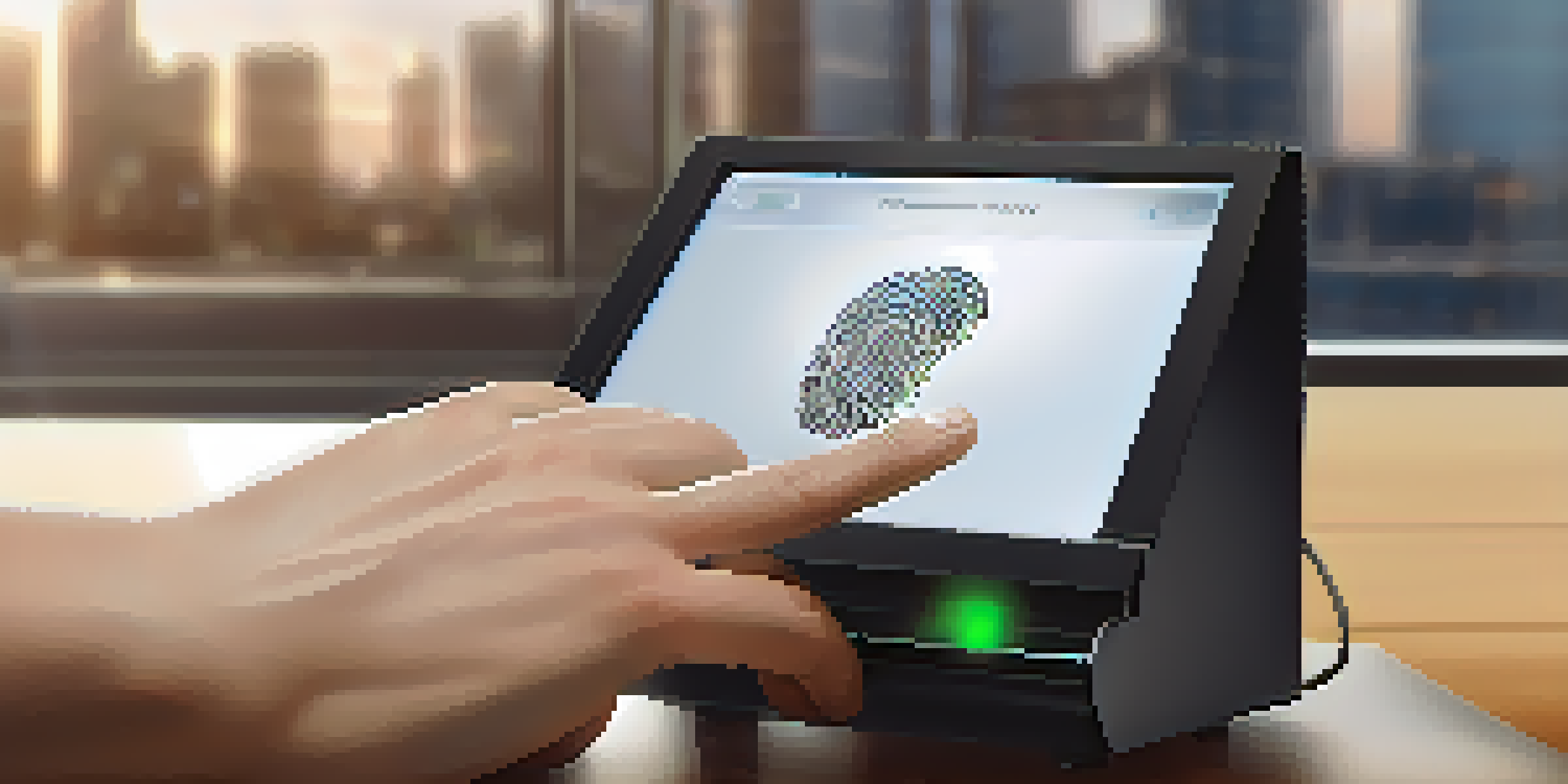How Biometrics is Transforming Security in Various Sectors

Understanding Biometrics and Its Key Components
Biometrics refers to the measurement and statistical analysis of people's unique physical and behavioral characteristics. This can include fingerprints, facial recognition, iris scans, and even voice patterns. By utilizing these traits, biometric systems provide a secure means of identification and authentication.
Biometrics is a powerful tool for enhancing security, but it must be implemented with care to ensure privacy and ethical use.
The technology behind biometrics has evolved rapidly, making it more accessible and reliable. For instance, the use of fingerprint scanners on smartphones exemplifies how everyday devices now incorporate biometric features. These advancements not only enhance security but also improve user convenience, allowing for seamless access.
As we delve deeper into the world of biometrics, it becomes clear that its applications extend far beyond personal devices. Various sectors are harnessing this technology to bolster their security measures, reflecting a growing trend toward more robust identity verification methods.
Biometrics in Healthcare: Enhancing Patient Security
In the healthcare sector, the secure management of patient data is paramount. Biometrics plays a crucial role in ensuring that only authorized personnel can access sensitive information. For example, hospitals are increasingly adopting fingerprint and facial recognition systems to verify staff identity before granting access to medical records.

Moreover, this technology can streamline patient check-in processes, reducing wait times and improving overall patient experience. Instead of relying on traditional ID cards, which can be lost or stolen, patients can use biometric identifiers that are unique to them. This not only enhances security but also minimizes the risk of identity theft.
Biometrics Enhance Security Across Sectors
From healthcare to finance, biometrics is revolutionizing security measures by providing reliable identification and authentication methods.
As healthcare facilities continue to embrace biometric solutions, the potential for improved patient security and privacy becomes more apparent. This transformation not only protects sensitive information but also builds trust between patients and healthcare providers.
Biometric Security in Financial Services: A New Era
The financial sector has also embraced biometrics, recognizing its ability to combat fraud and enhance security. Banks and financial institutions are implementing fingerprint and voice recognition systems to authenticate transactions, providing an additional layer of protection for customers. This shift towards biometric authentication helps reduce reliance on easily compromised passwords.
The future of security lies in the seamless integration of biometrics and technology, ensuring both safety and user convenience.
For instance, many mobile banking apps now offer users the option to log in using their fingerprints or facial recognition. This not only simplifies the user experience but also fortifies security measures, making it much harder for unauthorized individuals to gain access to accounts. It's a win-win for both banks and their customers.
As cyber threats continue to evolve, the adoption of biometric technologies in financial services is likely to grow. By implementing these advanced security measures, financial institutions can safeguard their clients' assets while fostering greater confidence in their services.
How Biometrics is Shaping Security in Retail
In the retail sector, biometrics is changing the way stores approach security and customer service. Retailers are using facial recognition systems to identify potential shoplifters and enhance overall store security. This proactive approach helps reduce losses and creates a safer shopping environment for customers.
Additionally, biometrics can improve customer experiences by enabling personalized services. For example, stores can use biometric data to track customer preferences and shopping habits, allowing them to tailor promotions and recommendations. This level of personalization not only boosts sales but also fosters customer loyalty.
Challenges of Biometric Privacy
While biometrics offers many benefits, concerns around privacy and data security must be addressed to ensure public trust.
With the integration of biometric technology, retailers are finding innovative ways to enhance security and improve customer interactions. As the retail landscape continues to evolve, embracing biometrics is becoming increasingly essential for success.
Biometrics in Government: Strengthening National Security
Governments around the world are leveraging biometric technologies to enhance national security and streamline identification processes. From border control to law enforcement, biometrics plays a critical role in verifying identities and preventing unauthorized access. For instance, many countries now use biometric passports that include fingerprint or facial recognition data.
In law enforcement, biometrics aids in criminal investigations by allowing authorities to quickly identify suspects through fingerprint databases or facial recognition technology. This not only speeds up the investigative process but also helps ensure public safety by swiftly apprehending offenders.
As the need for robust security measures continues to grow, governments are increasingly adopting biometrics. This shift reflects a commitment to leveraging technology for the safety and security of their citizens while also improving the efficiency of public services.
The Role of Biometrics in Education: Protecting Students
In educational institutions, biometrics is being utilized to enhance campus security and safeguard student identities. Schools are implementing fingerprint and facial recognition systems for student attendance and access control, ensuring that only authorized individuals can enter specific areas. This not only protects students but also enhances overall safety on campus.
Furthermore, biometric systems can help streamline administrative processes, such as enrollment and grading. By linking student identities to biometric data, schools can reduce the risk of fraud and ensure that records are accurate. This efficiency ultimately benefits both educators and students.
Future Innovations in Biometric Tech
Emerging technologies and AI advancements promise to improve the accuracy and efficiency of biometric systems, shaping the future of security.
As educational institutions continue to prioritize security, the integration of biometric technology is becoming increasingly vital. By adopting these systems, schools can create a safer environment while also improving operational efficiency.
Challenges and Concerns Surrounding Biometric Security
Despite the many advantages of biometrics, there are challenges and concerns that need addressing. One major issue is privacy; as biometric data is unique to individuals, its collection and storage raise questions about how this information is protected. Ensuring that biometric data is secure and used ethically is crucial to gaining public trust.
Additionally, the technology is not infallible. While biometric systems are generally reliable, they can still be susceptible to errors or manipulation. For example, facial recognition technology has faced criticism for inaccuracies, particularly among diverse populations. This highlights the need for continuous improvement and oversight in biometric implementations.

As we move forward into a biometric-driven future, balancing security with privacy concerns will be paramount. Addressing these challenges head-on will be essential for the widespread acceptance and success of biometric technologies.
The Future of Biometrics: Trends and Innovations
Looking ahead, the future of biometrics is promising, with ongoing innovations poised to enhance security across various sectors. Emerging technologies, such as behavioral biometrics, analyze patterns in user behavior, providing an additional layer of security. This means that even if a password is compromised, the system can recognize whether the user is acting within their usual patterns.
Moreover, advancements in artificial intelligence (AI) are expected to improve biometric accuracy and efficiency. AI can help reduce false positives and negatives, making biometric systems more reliable and user-friendly. As these technologies advance, we can anticipate a greater integration of biometrics into everyday life.
As we embrace these innovations, it’s clear that biometrics will play a pivotal role in shaping the future of security. By staying ahead of trends and continuing to improve biometric systems, we can create a safer, more secure world for everyone.